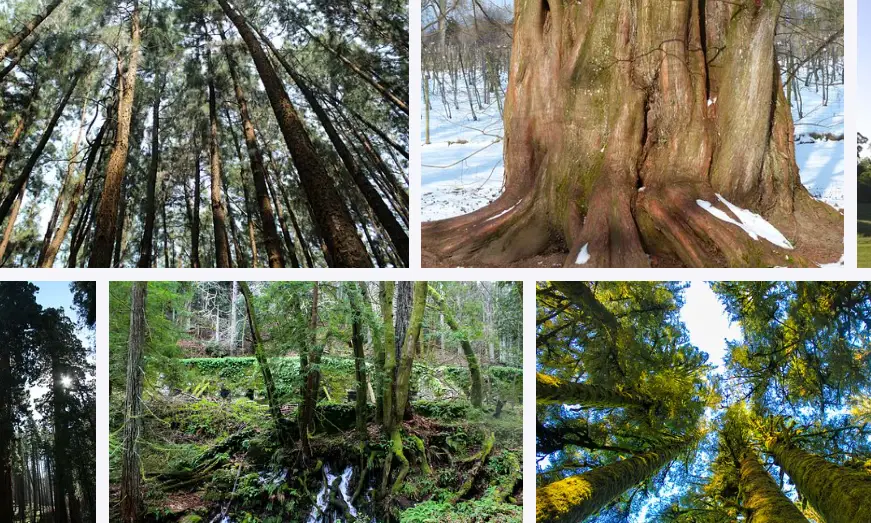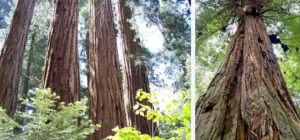Redwood Tree: Interesting Facts & Information

- By
- Aparna Patel
- |
- 26 Apr, 2023
- |

The majestic and towering Redwood Tree is a natural wonder that has fascinated people for centuries. Found primarily in the coastal regions of California, these incredible trees can grow to be over 300 feet tall and live for thousands of years.
In this blog post, we will explore some of the most interesting facts and information about the Redwood Tree, including its history, habitat, unique characteristics, and cultural significance. Join us as we dive into the fascinating world of the Redwood Tree, and discover why it continues to captivate and inspire people from all over the world.
Table of Contents
Interesting Facts About Redwood Tree
Redwood trees are among the largest and most impressive trees in the world. Here are some interesting facts and information about these majestic trees:
- Redwoods are found exclusively on the Pacific coast of North America, from southern Oregon to central California.
- The tallest tree in the world is a coast redwood named Hyperion, which stands at 379.7 feet (115.7 meters) tall in Redwood National Park, California.
- Redwoods can live for over 2,000 years, making them some of the oldest living things on Earth.
- The bark of a redwood tree can be up to 12 inches thick, which helps protect the tree from fire and insect damage.
- Redwoods are incredibly resistant to fire, due to their thick bark, high moisture content, and ability to resprout from the base.
- The wood of redwood trees is highly valued for its durability, resistance to decay, and attractive grain patterns. It is commonly used for outdoor construction, such as decking, fencing, and siding.
- Redwoods are important habitat for many species of plants and animals, including endangered species such as the marbled murrelet and the northern spotted owl.
- Redwood forests are also important for their role in storing carbon and helping to combat climate change.
- Redwoods are able to grow to such great heights because of their ability to transport water from the roots to the top of the tree through tiny tubes called xylem.
- The cones of a redwood tree are small and only open during fire or extreme heat, releasing their seeds to start new trees.
Redwood trees famous for what
Redwood trees are famous for being the tallest trees in the world and some of the largest trees in terms of volume. They are found primarily in the coastal regions of California in the United States, particularly in the Redwood National and State Parks.
The wood of redwood trees is also prized for its durability and resistance to decay, making it valuable for construction and other uses. Redwood trees are also important for their ecological role in providing habitat for a variety of wildlife species and contributing to the overall health of the forest ecosystem.
Overall, redwood trees are truly amazing and awe-inspiring, and are a testament to the resilience and beauty of nature.
What is so special about redwood trees
Redwood trees are special for many reasons. Here are a few of their unique features:
- They are the tallest trees in the world. The coast redwood (Sequoia sempervirens) is the tallest tree species, and can grow up to 379.7 feet (115.7 meters) tall.
- They are some of the oldest living things on Earth. Redwoods can live for over 2,000 years, and some have been found to be over 3,000 years old.
- They have thick, fire-resistant bark. The bark of a redwood tree can be up to 12 inches thick, which helps protect the tree from fire and insect damage.
- They are able to grow to great heights because of their ability to transport water from the roots to the top of the tree through tiny tubes called xylem.
- They play an important ecological role. Redwood forests are important habitat for many species of plants and animals, and are also important for their role in storing carbon and helping to combat climate change.
- They are culturally significant. Redwoods have been an important part of the culture of indigenous peoples in the region for thousands of years, and continue to be revered by many today.
Overall, redwood trees are special because of their impressive size and age, their unique adaptations to their environment, and their important ecological and cultural roles.
How long does it take for a redwood tree to grow full size
Redwood trees are known for their slow growth, and it can take several centuries for a redwood tree to reach full size. The growth rate of redwoods depends on several factors, including environmental conditions such as soil quality, moisture, and sunlight.
On average, it takes about 500 to 700 years for a redwood tree to reach its full size, which can be up to 300 feet (91 meters) tall and up to 30 feet (9 meters) in diameter at the base. However, some redwoods have been known to grow even larger and older, with some trees estimated to be over 2,000 years old.
It’s important to note that redwoods are not typically grown as commercial crops, and their slow growth and massive size make them difficult to cultivate. Most redwood forests are protected and managed as natural areas, and logging of old-growth redwoods is strictly regulated or prohibited in many areas.
Do redwood trees fall easily
Redwood trees are generally very sturdy and strong, and they have a number of adaptations that help them resist falling. For example, their wide, shallow root systems help anchor them firmly in the ground, and their thick, fire-resistant bark helps protect them from damage.
However, like all trees, redwoods can fall under certain conditions. High winds, heavy rains, and flooding can all increase the risk of a redwood tree falling. Additionally, if a redwood tree is damaged by fire, insects, or disease, it may be more prone to falling.
Can redwood trees grow anywhere
Redwood trees are a species that has specific environmental requirements, so they can only grow in certain regions. Specifically, redwoods are native to the coastal regions of northern California and southern Oregon, where the climate is mild and humid.
Redwoods prefer cool, moist conditions, with an average annual rainfall of at least 40 inches (100 cm) and temperatures that typically range between 40-60°F (4-16°C). They also require well-drained soils that are rich in organic matter.
While redwoods have been planted in other regions around the world, they are unlikely to thrive outside of their native range. Attempting to grow redwoods in unsuitable conditions can result in stunted growth, disease, and other problems.
In short, redwoods cannot grow just anywhere, and are only found naturally in specific regions with the right environmental conditions.
Where do redwood trees grow
Redwood trees are native to the coastal regions of northern California and southern Oregon in the United States. They grow in a narrow strip along the Pacific coast, extending from southern Oregon to central California.
Within this region, redwoods grow in areas that have a cool, humid climate with an average annual rainfall of at least 40 inches (100 cm). They also require well-drained soils that are rich in organic matter.
There are several redwood forests located in this region, including Redwood National and State Parks, which is home to some of the tallest and oldest redwood trees in the world. Other notable redwood forests in the region include Muir Woods National Monument, Big Basin Redwoods State Park, and Humboldt Redwoods State Park.
While redwoods have been planted in other parts of the world, they are only found naturally in this specific region of the United States.
Read more about redwoods
- Why are redwood trees so big?| How tall are redwood trees?
- What is Redwood National Park famous for?
- What city are the redwoods in California?
What climate do redwood trees grow in
Redwood trees grow in a cool, humid coastal climate with mild temperatures and abundant moisture. They are native to the coastal regions of northern California and southern Oregon, where the climate is characterized by mild, wet winters and cool, foggy summers.
Redwoods prefer a climate with an average annual rainfall of at least 40 inches (100 cm) and temperatures that typically range between 40-60°F (4-16°C). They also require well-drained soils that are rich in organic matter.
The coastal climate where redwoods grow is influenced by the Pacific Ocean, which helps to moderate temperatures and provide moisture in the form of fog and rainfall. This climate is unique to the coastal regions of northern California and southern Oregon, and is one of the key factors that allows redwoods to thrive in these areas.
In summary, redwoods grow in a cool, humid coastal climate with mild temperatures and abundant moisture, which is found in the coastal regions of northern California and southern Oregon.
Search Posts
Latest posts
-
4 Mar, 2024
How to make dining alone less awkward?
Popular posts
-
5 Mar, 2024
Why prohibit engine braking?
-
5 Mar, 2024
How to avoid drinking vodka?